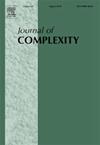Deep learning from strongly mixing observations: Sparse-penalized regularization and minimax optimality
IF 1.8
2区 数学
Q1 MATHEMATICS
引用次数: 0
Abstract
This paper considers deep learning from strongly mixing observations and performs a sparse-penalized regularization for deep neural networks (DNN) predictors. In a general framework that includes regression and classification, oracle inequalities for the expected excess risk are established, and upper bounds on the class of Hölder smooth functions and composition structured Hölder functions are provided. For nonparametric autoregression with the Gaussian and Laplace errors, and the Huber loss function, it is shown that the sparse-penalized DNN estimator proposed is optimal (up to a logarithmic factor) in the minimax sense. Based on the lower bound established in Alquier and Kengne (2024), we show that the proposed DNN estimator for the classification task with the logistic loss on strongly mixing observations achieves (up to a logarithmic factor), the minimax optimal convergence rate.
从强混合观测中深度学习:稀疏惩罚正则化和极大极小最优性
本文考虑从强混合观测中进行深度学习,并对深度神经网络(DNN)预测器进行稀疏惩罚正则化。在包含回归和分类的一般框架中,建立了期望超额风险的oracle不等式,并给出了Hölder平滑函数和组合结构化Hölder函数类的上界。对于具有高斯误差和拉普拉斯误差的非参数自回归,以及Huber损失函数,证明了所提出的稀疏惩罚DNN估计器在极小极大意义上是最优的(可达对数因子)。基于Alquier和Kengne(2024)中建立的下界,我们表明,对于具有强混合观测值的逻辑损失的分类任务,我们提出的DNN估计器实现了(高达对数因子)最小最大最优收敛速率。
本文章由计算机程序翻译,如有差异,请以英文原文为准。
求助全文
约1分钟内获得全文
求助全文
来源期刊

Journal of Complexity
工程技术-计算机:理论方法
CiteScore
3.10
自引率
17.60%
发文量
57
审稿时长
>12 weeks
期刊介绍:
The multidisciplinary Journal of Complexity publishes original research papers that contain substantial mathematical results on complexity as broadly conceived. Outstanding review papers will also be published. In the area of computational complexity, the focus is on complexity over the reals, with the emphasis on lower bounds and optimal algorithms. The Journal of Complexity also publishes articles that provide major new algorithms or make important progress on upper bounds. Other models of computation, such as the Turing machine model, are also of interest. Computational complexity results in a wide variety of areas are solicited.
Areas Include:
• Approximation theory
• Biomedical computing
• Compressed computing and sensing
• Computational finance
• Computational number theory
• Computational stochastics
• Control theory
• Cryptography
• Design of experiments
• Differential equations
• Discrete problems
• Distributed and parallel computation
• High and infinite-dimensional problems
• Information-based complexity
• Inverse and ill-posed problems
• Machine learning
• Markov chain Monte Carlo
• Monte Carlo and quasi-Monte Carlo
• Multivariate integration and approximation
• Noisy data
• Nonlinear and algebraic equations
• Numerical analysis
• Operator equations
• Optimization
• Quantum computing
• Scientific computation
• Tractability of multivariate problems
• Vision and image understanding.
 求助内容:
求助内容: 应助结果提醒方式:
应助结果提醒方式:


